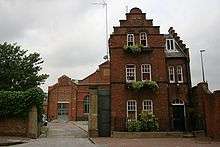London Hydraulic Power Company
The London Hydraulic Power Company was established in 1883 to install a hydraulic power network in London. This expanded to cover most of central London at its peak, before being replaced by electricity, with the final pump house closing in 1977.
History
The company was set up by an Act of Parliament (the London Hydraulic Power Company Act 1884), sponsored by railway engineer Sir James Allport,[1][lower-alpha 1] to install a network of high-pressure cast iron water mains under London. It merged the Wharves and Warehouses Steam Power and Hydraulic Pressure Company, founded in 1871 by Edward B. Ellington, and the General Hydraulic Power Company, founded in 1882. The network gradually expanded to cover an area mostly north of the Thames from Hyde Park in the west to Docklands in the east.[3]
The system was used as a cleaner and more compact alternative to steam engines, to power workshop machinery, lifts, cranes, theatre machinery (including revolving stages at the London Palladium and the London Coliseum, safety curtains at the Theatre Royal, Drury Lane, the lifting mechanism for the cinema organ at the Leicester Square theatre and the complete Palm Court orchestra platform),[1] and the backup mechanism of Tower Bridge.[3] It was also used to supply fire hydrants, mostly those inside buildings. The water, pumped straight from the Thames, was heated in winter to prevent freezing.[1]
Pumping stations

The pressure was maintained at a nominal 800 pounds per square inch (5.5 MPa) (55 BAR) by five hydraulic power stations, originally driven by coal-fired steam engines.[1] These were at:
- Falcon Wharf Pumping Station at Bankside, east of Blackfriars Bridge on the south bank of the River Thames (opened in 1883)[4]
- Kensington Court and Millbank (1887)[4] later (1911) replaced by a station in Grosvenor Road[5]
- Wapping Hydraulic Pumping Station (est. 1890),[4] using the defunct Tower Subway to carry pipes under the Thames (closed on 30 June 1977, the last to be used)[5]
- City Road Basin on the Regent's Canal in Islington (1893),[4] later used as the Marico furniture factory[5]
- Renforth Pump House (Rotherhithe, Canada Water) (opened in 1904),[4] now residential accommodation
Short-term storage was provided by hydraulic accumulators, which were large vertical pistons loaded with heavy weights.
Cross-River Thames mains
The mains crossed the River Thames via Vauxhall Bridge, Waterloo Bridge and Southwark Bridge and via the Rotherhithe Tunnel as well as the Tower Subway.[6]
Decline
The system pumped 6.5 million gallons of water each week in 1893; this grew to 32 million gallons in 1933.
From about 1904, business began to decline as electric power became more popular. The company began to replace its steam engines with electric motors from 1923. At its peak, the network consisted of 180 miles (290 km) of pipes, and the total power output was about 7,000 horsepower (5.2 MW).
The system finally closed in June 1977. The company, as a UK statutory authority, had the legal right to dig up the public highways to install and maintain its pipe network. This made it attractive to Mercury Communications (a subsidiary of Cable & Wireless) who bought the company and used the pipes as telecommunications ducts.[3][7] Wapping Hydraulic Power Station, the last of the five to close, later became an arts centre and restaurant.
References
- Some accounts incorrectly name him as Sir John Allport. Sir James had direct experience of hydraulic power, having deployed the technology to power cranes at Newcastle-upon-Tyne Central railway station.[2]
- "Hydraulic Power Company - article is adapted from a talk given in November 1979 by Mr Donnachie to the Lambeth and Southwark Archaeological Society". Archived from the original on January 27, 2008. Retrieved 1 January 2016.CS1 maint: unfit url (link)
- Allport, SIR J.; Chatwood, S.; Coates, J.; Smith, R. H.; Webster, J. J.; Ellington, E. B.; Armstrong, W. G.; Harrison, T. E. (1888). "Correspondence. The Distribution of Hydraulic Power in London". Minutes of the Proceedings of the Institution of Civil Engineers. 94 (1888): 77–85. doi:10.1680/imotp.1888.20881.
- Emmerson, Andy. "Hydraulic power in London". Subterranea Britannica. Retrieved 1 January 2016.
- Skinner, Steve (2014). Hydraulic Fluid Power - A Historical Timeline. p. 77. ISBN 9781291676891.
- Morgan, Roger (28 July 1977). "Watery Death of Electricity's Rival". New Scientist: 221–223.
- "London's Hydraulic Power". Mike's Engineering Wonders: Vintage Pages from the 1930s. Retrieved 1 January 2016.
- Information, Reed Business (21 March 1985). "Mercury plugs into hydraulic ducts". New Scientist (1448): 7. Retrieved 3 January 2016.
Further reading
- McNeil, Ian (1972). Hydraulic Power. Longman Group. ISBN 978-0-582-12797-5.CS1 maint: ref=harv (link)
- Pugh, B. (1980). The Hydraulic Age. Mechanical Engineering Publications. ISBN 0-85298-447-2.CS1 maint: ref=harv (link)